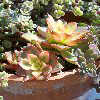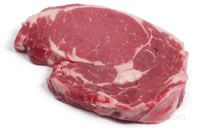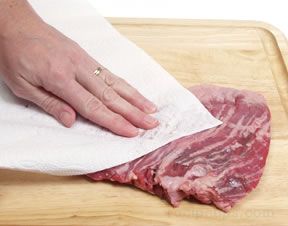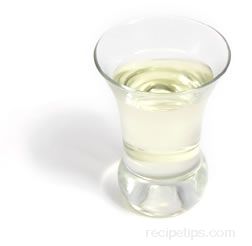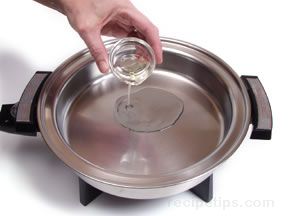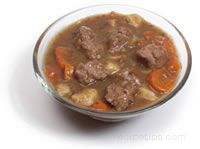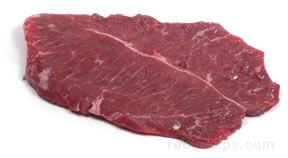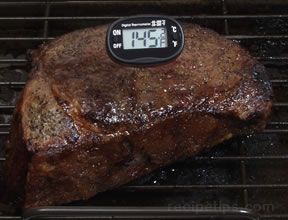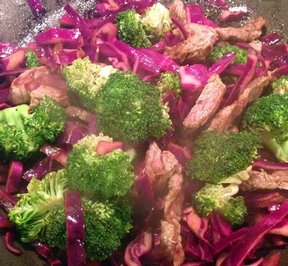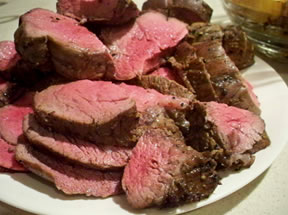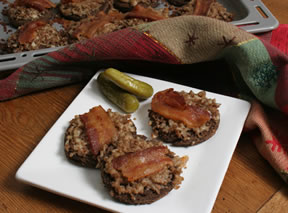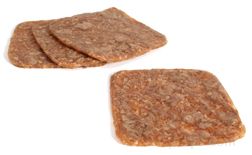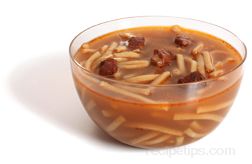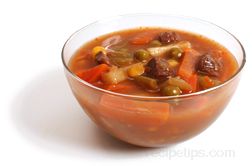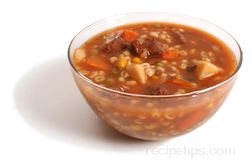|
There are a number of flavorful beef recipes that you can use when roasting beef, but if the proper cut is not used, the meat can become dry and tough even though it may have great flavor. There are several types of beef cuts that are suitable for cooking with the roasting method. Rib eye roasts, top loin roast, and rib roasts are examples of suitable cuts. Although roasting is a good method for cooking beef, there are many other cooking methods that can be used for cooking all types of beef. For information on other cooking methods, see the Beef Cooking Guide.
| ||||||||||||||||||||||||||||||||||||||||||||||||||||||||||||||||||
|
The following roasting method works well for beef cuts that weigh about 2½ pounds. Adjustments in the roasting time will have to be made if using a smaller or larger piece of meat. A top sirloin butt roast, a tri-tip roast, or a top quality bottom round roast are good choices when using the following steps. | |
|
Preheat the oven to 450°F. Remove the beef roast from the refrigerator and season the meat as desired. The meat may also be marinated for several hours before it is roasted. This may be especially desirable if roasting a bottom round (pictured right), because even a top quality bottom round roast will not be as tender as the top sirloin butt or tri-tip roast. The marinating process will help to tenderize the meat. |
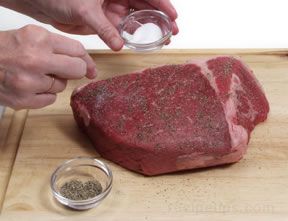 |
| Note: Cooking a small roast at high heat helps to sear the exterior, which provides a flavorful brown crust and tender meat on the inside. |
| Place the beef on a rack in a shallow roasting pan with the fat side up. Do not cover the roast and do not add any liquid (liquid is used for braising, not roasting). | 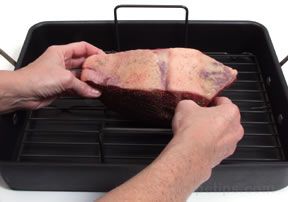 |
| Allow the beef to roast at 450°F for 45 minutes and then begin checking the internal temperature of the meat with a meat thermometer. Continue roasting the meat until the internal temperature has reached 5 or 10 degrees below the desired doneness. The total roasting time depends on the type of beef cut that is roasted, the weight of the beef cut, the level of doneness desired, and the accuracy of the oven. Generally, the roasting time may range from 15 to 30 minutes per pound. The 2½ pound, bottom round roast pictured on the right, required 55 minutes cooking time to reach the desired doneness, which in this case is medium rare to medium. | 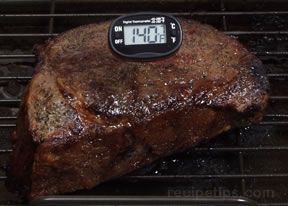 |
| Remove the roast from the oven and place aluminum foil loosely over the meat to hold in the heat. Let the roast stand for 15 minutes. The temperature will continue to rise 5 or 10 degrees, reaching the proper doneness. The resting period will allow the juices to settle in the roast making it more tender and easier to carve. |  |
|
A beef roast cooked to medium-rare should have an internal temperature of 145°F - 150ºF after the resting period, and a roast cooked to medium should have an internal temperature of 150°F to 160ºF. (See the note below). See Beef Doneness for more information on proper cooking temperatures. |
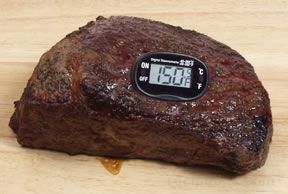 |
| Note: Traditional guidelines state that beef cooked very rare, rare, or medium-rare should have an internal temperature ranging between 115ºF to 140°F; however, with increased concern over bacteria that may be present in the internal portions of beef, the USDA recommends that whole beef cuts be cooked to an internal temperature of not less than 145°F (the final internal temperature after the resting period). |
Steps for Roasting a Beef Tenderloin

|
| Note: Some beef cuts that are usually undesirable for roasting, such as cuts from the plate or flank, may be improved considerably if they are marinated first before roasting. Marinating helps to soften the tough fibers, making the meat tender. |
Steps for Roasting a Prime Rib
|
Prime rib is a common name given to the beef cut, standing rib roast, or if the roast is boneless, it may be referred to as a rolled rib roast. "Prime Rib" is a misleading name because many people assume that the meat is graded prime (by the USDA) when actually this is not the case in most instances. Prime is the top quality possible and represents only about 2% of the beef that is graded. It has the most marbling (the visible fat running throughout the meat), which makes it the most flavorful and tender. In most cases, prime grade beef is available only at fine restaurants, and occasionally it may be found in specialty meat markets, but it is rarely ever found in supermarkets. There was a time, however, when rib roasts that were actually graded prime were more common than they are now, but the cost became so exorbitant that they are now only available at supermarkets through a special order. Most rib roasts sold in food stores are graded choice, and although this is one grade below prime, the roast is still quite desirable. Because of its size, a full rib roast (ribs 6 through 12) is often cut and sold as two separate roasts known as the first cut rib roast and the second cut rib roast. The first cut is also called a small end rib roast and includes ribs 9 or 10 through 12, which is next to the loin primal. The second cut, also known as the large end rib roast, includes ribs 6 through 8 or 9 and is next to the chuck primal. Although it is very tender, its proximity to the chuck means that it is slightly less desirable than a first cut rib roast.
Standing Rib Roast and Boneless Rolled Rib Roast When determining the size of the prime rib roast that you will need, figure that each rib will feed two people. A three rib roast will feed five or six people, a four rib roast will serve seven or eight people, and so on. It is best not to prepare a rib roast of less than three ribs because it may be difficult to cook it properly. The smaller size increases the possibility of overcooking the meat. |
| Preparing the Prime Rib for Roasting | |
| A prime rib roast does not require too much preparation before it is cooked. The meat is much easier to work with when the butcher removes the bones: the rib bones along the edge of the roast, which are connected to the chine bone along the bottom. The rib and chine bones can be removed as one piece, with some meat and fat left between the individual ribs in order to hold everything together so that it can be cooked as a separate piece if desired. | 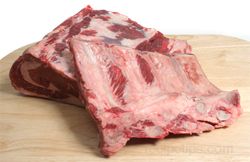 |
|
It is much easier to carve a boneless rib roast when it is ready to serve than one that still includes the bones; however, it is beneficial to cook the bones with the boneless meat in order to provide the rib roast with additional flavor and moistness. To this end, if you have previously removed the bones from the roast, it will be necessary to tie the bones to the meat prior to cooking (see Tying Beef: Tying a Rib Roast for more information); however, before tying the roast, the fat should be trimmed in any areas where it is over an inch thick. Care must be taken so that too much fat is not removed. A minimum of one-quarter inch of fat should be left on the meat, which will help to seal in moistness and provide flavor. |
|
| When the prime rib roast is properly trimmed and tied, it should be left covered at room temperature for two hours (assuming the room temperature is an average of 68ºF). Roasting cold meat directly from the refrigerator will result in meat that is overdone on the exterior before the internal temperature has reached the desired doneness; however, considerations must be taken into account for the actual temperature of the room in relation to the time the meat is away from refrigeration or from the heat of an oven. It may not be wise to leave the meat sitting for two hours in a room that is excessively warm (above 80ºF) because of concerns of foodborne illness resulting from food exposed to temperatures conducive to rapid growth of harmful bacteria. In this case, a time of only an hour and a half may be required to warm the meat sufficiently prior to roasting. | 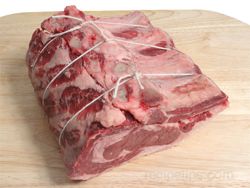 |
| After the prime rib has reached room temperature, rub the entire surface with pepper and kosher salt. This is often the best way to bring out the flavor of the meat; however, many people like to include other flavorings that are either rubbed onto the surface of the meat or added to a flavoring liquid that is used to marinate the meat for a period of time. A rib roast certainly does not need to be marinated to tenderize it because it is already a naturally tender beef cut, but a marinade (or a rub) may be used when specific flavors are desired in the meat (see note box below). | 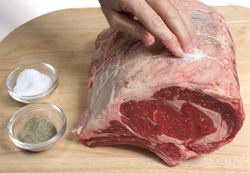 |
| Note: To marinate the meat, place the prime rib in a dish or pan with sides (do not use plastic). Using a fork, poke holes throughout the roast; pour the marinade over the meat; cover; and place it in the refrigerator for two hours. Turn the roast in the marinade every thirty minutes. When the marinating time is finished, remove the meat from the marinade and allow it to sit at room temperature for one to two hours prior to roasting. |
| Place the roast, rib side down, in a baking pan or roasting pan that has high sides. A pan with a rack is not required because the bones act as a natural rack for the prime rib meat. The prime rib is now ready to be placed into the oven for roasting. | 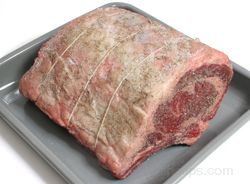 |
|
Roasting the Prime Rib The most important point to remember when cooking a prime rib roast is to ensure that the meat is not overcooked. An expensive cut of beef, such as a prime rib roast, is most often best in flavor and tenderness when it reaches a doneness level of no greater than medium-rare; however, many chefs recommend that it be served rare. The meat will toughen rapidly when cooked too long (any level above medium), so it is important to watch it carefully during the roasting time. Use a reliable meat thermometer to ensure that the internal temperature of the meat does not exceed the level of desired doneness. |
| Note: The temperatures for doneness stated in this article are not recommended by the USDA but are accepted levels of doneness for prime rib recommended by many chefs. See Beef Doneness for information concerning the USDA accepted standards for cooking beef. |
|
A Typical Procedure for Cooking Prime Rib
|
|
Estimated Cooking Times The cooking times in this chart are based upon a cooking Use a meat thermometer to ensure that | ||
|
No. of Ribs / |
Estimated Cooking Time | |
|
Rare 120°F to 125°F |
Medium Rare 130°F to 135°F | |
|
3 Ribs |
1-1/4 to 1-1/2 hrs. | 1-1/2 to 1-3/4 hrs. |
| 4 Ribs 8.5 to 10 lbs. |
1-1/2 to 2 hrs. | 1-3/4 to 2-1/4 hrs. |
| 5 Ribs 10.5 to 13 lbs. |
2 to 2-1/2 hrs. |
2-1/4 to 2-3/4 hrs. |
| 6 Ribs 14 to 16 lbs. |
2-1/2 to 3 hrs. | 3 to 3-1/2 hrs. |
| 7 Ribs 16.5 to 18 lbs. |
3 to 3-1/2 hrs. | 3-1/2 to 4 hrs. |
|
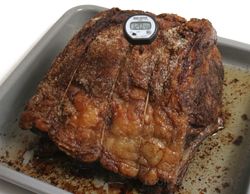 |
| |
|
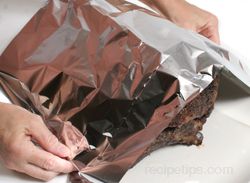 |
|
Serving the Prime Rib When the resting period has concluded, the prime rib can be carved and served. Refer to "Carving Beef" Steps for Carving a Prime Rib Roast for information regarding the proper method of carving of the meat.
Au jus is prepared from the meat drippings produced while the prime rib is cooking. After the meat is removed from the pan and is allowed to rest, fat is removed from the drippings in the pan, additional broth is added, the juices are boiled, the roasting pan is deglazed to remove the flavorful bits from the pan, seasoning is added, and the juices are strained (if desired). See Prime Rib Serving Suggestions in "Kitchen Techniques" for detailed information on how to prepare au jus. |

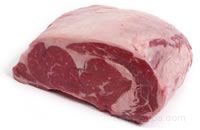




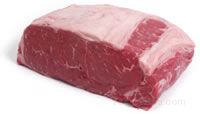
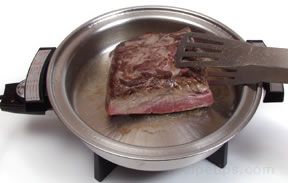
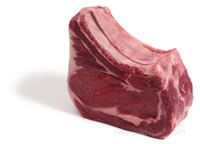
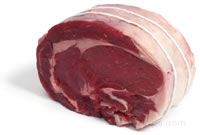
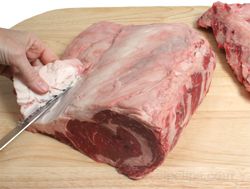
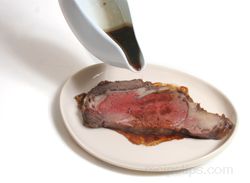 Prime rib is often served au jus (pronounced oh zhoo'), which is French for "with juice." Since au jus means "with juice," it is more proper to refer to prime rib as being "served au jus" rather than referring to it as "served with au jus," which would actually mean "served with with juice." The juices are spooned over the meat when it is served.
Prime rib is often served au jus (pronounced oh zhoo'), which is French for "with juice." Since au jus means "with juice," it is more proper to refer to prime rib as being "served au jus" rather than referring to it as "served with au jus," which would actually mean "served with with juice." The juices are spooned over the meat when it is served.
